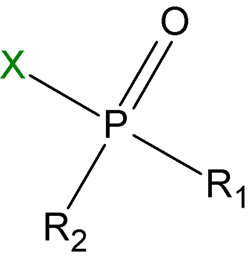Organophosphates
Organophosphates are a group of organic phosphorus compounds characterized by high lipophilicity and, above all,the ability to inhibit acetylcholinesterase (AChE).
Toxicology of organophosphates[edit | edit source]
Toxicokinetics[edit | edit source]
Organophosphates are absorbed very quickly. They can be absorbed transdermally (very well trough the skin intact), inhaled or ingested orally. Thanks to their high lipophilicity, they are very easily concentrated in nervous tissue, where the site of their toxicological effect is located.
The metabolism of organophosphates is different for different compounds. It can lead to detoxification (e.g. malathion) or also to activation.
Mechanism of action[edit | edit source]
The mechanism of action of organophosphates consists inthe irreversible inhibition of AChE, for which the organophosphate is a so-called "suicide" substrate. After cleavage, the rest of the organophosphate molecule remains irreversibly bound in the active site of AChE ..
Symptoms[edit | edit source]

R1 and R2 are the general formulas of hydrocarbon residues, respectively their derivatives, which adjust the physicochemical properties of the organophosphate. They can be, for example, an alkyl group, an alkoxy group, an amino group
X is then an easily cleavable group that withdraws during cleavage and the remainder binds to AChE. It can be, for example, a halogen, a cyanide group, or a thio group
The initial symptoms depend on the method of intoxication. When exposed to vapors, the eye and the respiratory system are the first to be affected, while after oral ingestion, the poisoning first manifests itself by affecting the gastrointestinal tract. Further, typical symptoms of acetylcholine poisoning develop , such as:
- excessive salivation and sweating,
- leakage or urine and stool,
- muscle fasciculations to paralysis,
- confusion, ataxia, loss of reflexes up to coma .
Death in acute intoxication is the result ofbronchospasm and paralysis of the respiratory muscles.
Late neurotoxic effects occur about 14 days after poisoning, when severe paralysis and muscle atrophy occur as a result of damage to muscle plates and demyelination of motoneurons.
Therapy[edit | edit source]
The therapy consists in securing vital functions, preventing the penetration of the poison into the organism (leaving the infested area, removing contaminated clothing), followed by the administration of atropine (in case of severe scopolamine, benactysine poisoning):
Atropine 2-5 mg intravenously, at intervals of 5-15 minutes, repeat until clear atropinization (check according to the dryness of the mucous membrane of the oral cavity, or according to the amount of bronchial secretion in intubated patients). Atropine tolerance is very high in organophosphate poisoning. Individual doses for children: 1-3 mg.
We also administer AChE reactivators and anticonvulsants. Reactivators are substances that can release organophosphates from binding to AChE; atropine then, as an antagonist of acetylcholine, reduces its effect on receptors. AChE reactivators include:
- pralidoxie
- obidoxime
- methoxime
- trimedoxime
- HI-6
Reactivators must be administered preferably minutes, maximum hours after poisoning, because AChE complexes with organophosphate residues become resistant to the administration of reactivators over time.
Furthermore, symptomatic therapy is used in case of poisoning , for example the administration of diazepam against convulsions. There is no recommended therapy for the late effects of poisoning.
Examples of organophosphates[edit | edit source]
- Insecticides
- Organophosphates are often used in insecticides; examples of substances: parathion, dimethoate, fonofos, malathion and many others.
- Combat agents
- Organophosphates also include combat toxic substances such assarin or novichok. Historically mentioned soman, tabun.
- Indirect cholinomimetics
- Some organophosphates were also used in medical practice, for example paraoxon, which was once indicated as a miotic agent. Today, only substances from the group of reversible AChE inhibitors are used as indirect cholinomimetics.
Links[edit | edit source]
Related articles[edit | edit source]
Sources[edit | edit source]
- MLADĚNKA, Přemysl. Acetylcholin [lecture for subject Farmakologie, specialization Farmacie, Farmaceutická fakulta Univerzita Karlova]. Hradec Králové. duben 2011. seminář z farmakolofie.
References[edit | edit source]
- VOPRŠALOVÁ, Marie – ŽÁČKOVÁ, Pavla. Základy toxikologie pro farmaceuty. 1. edition. Praha : Karolinum, 2000. 0 pp. ISBN 80-7184-282-6.
